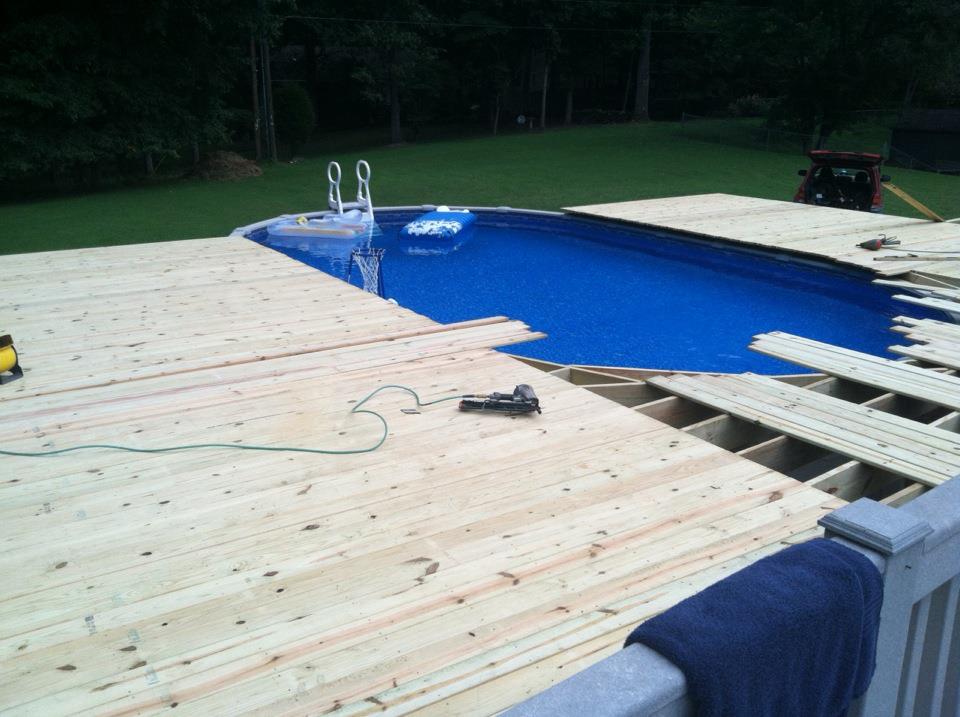Having an above ground pool may not seem as luxurious as having an inground pool, but if you have seen any deck designs of above ground pools you will see that you can have a deck built to the top of your pool and with many different customizations they can be just as elegant as an inground pool. Even if you have an inground pool budget, looking into having an above-ground pool with a custom deck can often be a more usable alternative.
There are many different decisions you will need to make before getting your deck built, including location, size, shape, height, wood, and stain.
1. Location
Where you put your pool and deck is one of the biggest decisions you will need to make for this project. You will want your pool far enough away from your house so it is not out your back door, but close enough you can keep an eye on anyone that is swimming in it.
You might hear the word deck and think of attached to your house, and that you will have to put your above-ground pool very close to your house. However, there are many amazing pool designs that allow you to build a deck unattached to your house, plus you may have more options of shape and size if it is a stand-alone feature. If you have small children you may want to consider having an unattached deck so they are able to go outside without you having to worry about them walking by the pool every time, or you could fence off the pool with a locked gate.
2. Size
The size of your pool deck is very dependant on your budget, the amount of space you have in your backyard, and the size of your pool. Decks can come in any size, from simply a wooden ladder to a small surface making a single entrance to your pool to having a full wrap-around deck with enough room for a table, grill, hot tub, and enough walking room for your whole family. You might need to decide on the size of your deck in order to pick your location as well.
3. Shape
When deciding on the shape of your deck think about what you want the deck to be for. If you want a 360 degree walk around the pool, sun tanning chairs, or have a special location built just for eating, or grilling.
4. Height
Don’t just think about length and width when deciding your deck’s shape. There are many options on how high your deck is as well. Building a separate area of your deck either lower or higher than around your pool will separate your spaces and give a more luxurious feel.
The height of an above-ground swimming pool is usually around 52 to 54 inches. Decks can either be built just to the bottom side of the top rails, or they can be built higher than your pool and overhang on top of the top rails. Both deck designs will work fine. We prefer installing your deck just under the top rail of your pool. We feel it gives the pool and deck a better fit and finish. Laying your decking over your top rails can leave the ends of boards facing the pool, which can eventually splinter. Just remember that you should leave 1/2 inch between your pool and deck to protect against expansion of your pool when filled with water.
5. Wood
There are many options for wood when building a deck for your pool. You will have to decide on how much you want to spend as well the future maintenance.
Pressure Treated
The most important aspect of picking out wood is getting wood that will fit your budget and last for years. Your deck will be out in the elements and will hold up better if built with treated lumber, but having one built around a pool will get wet much more often. Commonly used treatment includes southern yellow pine. However, if not taken care of yellow pine can splinter easily.
Hardwoods
A few other types of lumber include red balau, golden ironwood, ipe, acambara, and cumaru. The latter options are hardwoods and will be less prone to splintering. They are usually more expensive, heavy, and can be a pain to work with (needing to pre-drill your holes). If you live in a hot area avoid using dark woods as they will absorb the sun’s heat and because extremely hot to walk on.
Redwood and Cedar
These types of wood are naturally resistant to many insects. They are also lightweight and easy to work with while lasting for at least 20 years. The downside to them is that they can be worn down by foot traffic and the sun. They should be stained with a sun-blocking finish every few years.
Composite
Most likely the best yet most expensive option is composite. They are often made by combining waste wood fibers and plastic. They will not splinter (extremely important for a poolside deck), and they don’t need to be stained and maintained every few years. If you can afford composite wood and don’t mind that it is not going to look as natural as real wood, a composite is definitely worth looking into.
6. Stain
If you read that last section and decided on composite wood, you will not need this step. However, most decks will be made of real wood and will need a stain to keep them looking new and lasting through all of your pool parties. Petroleum/oil-based stains that sink absorb into the wood will last the longest and be repel more water.
7. Enjoy
That’s it! The next step is relaxing and enjoying your beautiful pool on your new deck!


You must be logged in to post a comment.